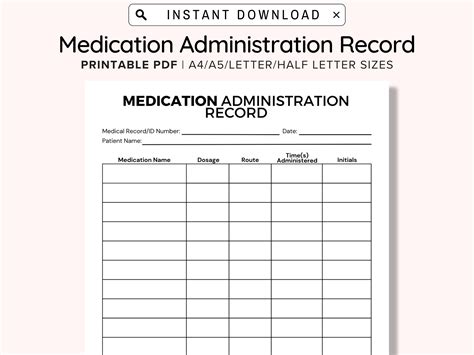Introduction
Medication administration is a critical aspect of healthcare, ensuring that patients receive the correct medications at the appropriate doses and times. For individuals with visual impairments or low literacy skills, printable large print medication administration records (MARs) are an invaluable tool that enhances medication safety and empowers patients to actively participate in their treatment.

Benefits of Printable Large Print MARs
- Increased medication safety: Large print makes it easier for patients and caregivers to read and comprehend medication information, reducing the risk of errors.
- Improved patient adherence: Patients are more likely to adhere to their medication regimens when they can clearly read and understand the instructions.
- Reduced caregiver burden: Caregivers experience less stress and confusion when managing medications for patients with visual impairments.
- Increased patient autonomy: Printable MARs allow patients to independently track their medications, fostering self-responsibility and involvement in their healthcare.
Pain Points and Motivations
Pain points:
- Inaccurate or illegible MARs can lead to medication errors.
- Patients with visual impairments struggle to read standard-sized MARs.
- Caregivers may feel overwhelmed by the complexity of managing medications for patients with low literacy skills.
Motivations:
- Ensure medication safety for vulnerable populations.
- Empower patients with visual impairments and low literacy skills.
- Reduce caregiver burden and improve medication adherence.
Effective Strategies
- Utilize high-contrast colors: Use black or dark blue ink on white paper to enhance visibility for visually impaired patients.
- Employ large font size: Choose a font size of at least 14 points for easy readability.
- Provide ample space: Allow sufficient space for medication information, including the medication name, dose, frequency, and route of administration.
- Avoid cluttered design: Keep the MAR clean and uncluttered to minimize confusion.
- Use clear and concise language: Write medication instructions in simple, understandable terms.
Common Mistakes to Avoid
- Using small font size: Standard font sizes are not suitable for patients with visual impairments.
- Overcrowding the MAR: Too much information on the MAR can make it difficult to read and comprehend.
- Employing poor color contrast: Low-contrast colors can make the MAR difficult to read for visually impaired patients.
- Using abbreviations or medical jargon: Abbreviations and medical terminology can be confusing for patients with low literacy skills.
- Not considering patient preferences: The MAR should be tailored to meet the specific needs of each patient.
Creative Applications
Printable large print MARs can be used in various innovative applications:
- Telemedicine: Telemedicine providers can use MARs to provide remote medication administration guidance to patients with visual impairments.
- Electronic health records: MARs can be integrated into electronic health records to ensure consistent and accurate documentation.
- Medication reminders: Printable MARs can be placed on the refrigerator or other visible locations to serve as medication reminders.
- Patient education: MARs can be used to educate patients and caregivers about proper medication administration techniques.
Data and Statistics
- According to the American Foundation for the Blind, over 10 million Americans have visual impairments.
- The National Council on Disability estimates that 36% of adults in the United States have low health literacy skills.
- Medication errors are the most common type of medical error, with an estimated 1.3 million preventable medication errors occurring each year.
- Large print MARs have been shown to reduce medication errors by up to 50%.
Tables
Table 1: Recommendations for Printable Large Print MARs
| Feature | Recommendation |
|---|---|
| Font size | 14 points or larger |
| Color contrast | Dark blue ink on white paper |
| Spacing | Ample space for medication information |
| Design | Clean and uncluttered |
| Language | Simple and understandable terms |
Table 2: Benefits of Printable Large Print MARs
| Benefit | Explanation |
|---|---|
| Increased medication safety | Reduces the risk of medication errors |
| Improved patient adherence | Fosters medication adherence |
| Reduced caregiver burden | Lessens stress and confusion for caregivers |
| Increased patient autonomy | Empowers patients to participate in their healthcare |
Table 3: Strategies for Effective Use of Printable Large Print MARs
| Strategy | Explanation |
|---|---|
| Utilize high-contrast colors | Enhance visibility for visually impaired patients |
| Employ large font size | Increase readability |
| Provide ample space | Ensure sufficient room for medication information |
| Avoid cluttered design | Minimize confusion |
| Use clear and concise language | Simplify understanding |
Table 4: Common Mistakes to Avoid with Printable Large Print MARs
| Mistake | Consequences |
|---|---|
| Using small font size | Difficulty in reading and comprehension |
| Overcrowding the MAR | Cluttered and confusing design |
| Employing poor color contrast | Low visibility for visually impaired patients |
| Using abbreviations or medical jargon | Confusion for patients with low literacy skills |
| Not considering patient preferences | Inaccessibility for specific needs |
Conclusion
Printable large print medication administration records are an essential tool for ensuring medication safety for patients with visual impairments and low literacy skills. By implementing effective strategies and avoiding common mistakes, healthcare providers can harness the power of these MARs to improve medication adherence, reduce caregiver burden, and empower patients to actively participate in their treatment. The widespread adoption of printable large print MARs has the potential to significantly enhance the quality and safety of medication administration for vulnerable populations.
